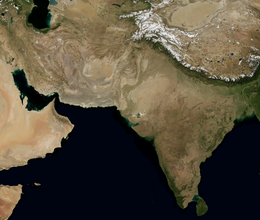This article needs additional citations for verification. (November 2019) |
 | |
| Continent | Asia |
|---|---|
| Region | South Asia, Indian subcontinent |
| Coordinates | 30°00′N 70°00′E / 30.00°N 70.00°E |
| Area | Ranked 33rd |
| • Total | 881,913 km2 (340,509 sq mi) |
| • Land | 97.14% |
| • Water | 2.86% |
| Coastline | 1,046 km (650 mi) |
| Borders | Total: 7,307 km (4,540.4 mi) Afghanistan: 2,670 km (1,659.1 mi) China: 559 km (347.3 mi) India: 3,320 km (2,063.0 mi) Iran: 959 km (595.9 mi) |
| Highest point | K2 8,611 m (28,251 ft) |
| Lowest point | Indian Ocean 0 m (0.0 ft) |
| Longest river | Indus River |
| Largest lake | Manchhar Lake |
| Exclusive economic zone | 290,000 km2 (110,000 sq mi) |
The Geography of Pakistan (Urdu: جغرافیۂ پاکِستان) encompasses a wide variety of landscapes varying from plains to deserts, forests, and plateaus ranging from the coastal areas of the Indian Ocean in the south to the mountains of the Karakoram, Hindukush, Himalayas ranges in the north. Pakistan geologically overlaps both with the Indian and the Eurasian tectonic plates where its Sindh and Punjab provinces lie on the north-western corner of the Indian plate while Balochistan and most of Khyber Pakhtunkhwa lie within the Eurasian plate which mainly comprises the Iranian Plateau.
Pakistan is bordered by India to the east, Afghanistan to the northwest and Iran to the west while China borders the country in the northeast. The nation is geopolitically situated within some of the most hostile regional boundaries which share disputes and have many times escalated military tensions between the nations i.e., that of Kashmir with India. Its western borders include the Khyber Pass and Bolan Pass that have served as traditional migration routes between Central Eurasia and South Asia.